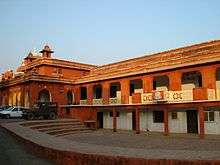Colvin Taluqdars' College
Colvin Taluqdars' College in Lucknow is one of the oldest private schools in India.
Colvinians | |
 | |
| Motto | Noblesse Oblige |
|---|---|
| Type | Private, Education |
| Established | 1889 |
| Principal | Mr Anoop Raj |
| Location | , , |
| Campus | Urban, a 60-acre (240,000 m2) campus built on the banks of the river, Gomti |
| Colors | Blue (Tranquility) |
| Mascot | Sickle with an ear |
| Website | |
History
Sir Auckland Colvin, Lieutenant Governor of the North West Provinces, while functioning as Lieutenant Governor of Avadh and Agra in 1889, conceived the idea of a school with the object of imparting education to the children of the British administrators and the landed aristocracy who were known as Taluqdars. The 'wards' class, founded in 1884, formed the nucleus for the establishment of the Taluqdars' College. The first Principal was Henry George Impey Siddons, the son of a Captain in the Indian Army, who graduated at Oxford and returned to India to teach. From 1875 to 1884 he had been first headmaster, then Principal, of the Muhammadan Anglo-Oriental College, Aligarh, subsequently holding other teaching posts in India.
Only when the British left India in 1947 did it open its doors to the general public. By that time, it had along with, Rajkumar College, Raipur, Aitchison College in Lahore and Mayo College in Ajmer acquired reputation as the top school in the Indian plains. The Governor of the state of Uttar Pradesh is the patron of the College.
Education
The school is affiliated to the Council for the Indian School Certificate Examination, New Delhi in 1980 and recognise by UP board in 1948. Day scholars as well as boarders study at Colvin which has no religious affiliations. The school has a library and an online media-access lab. The school has become co-educational up to class V . The college has produced 100% pass in ICSE, and ISC both in the session 2015 which is a record since the opening of ISC in the school in 1983. Earlier session's result in ISC was 100% with fresh pass out in I.I.T Dhanbad.
References